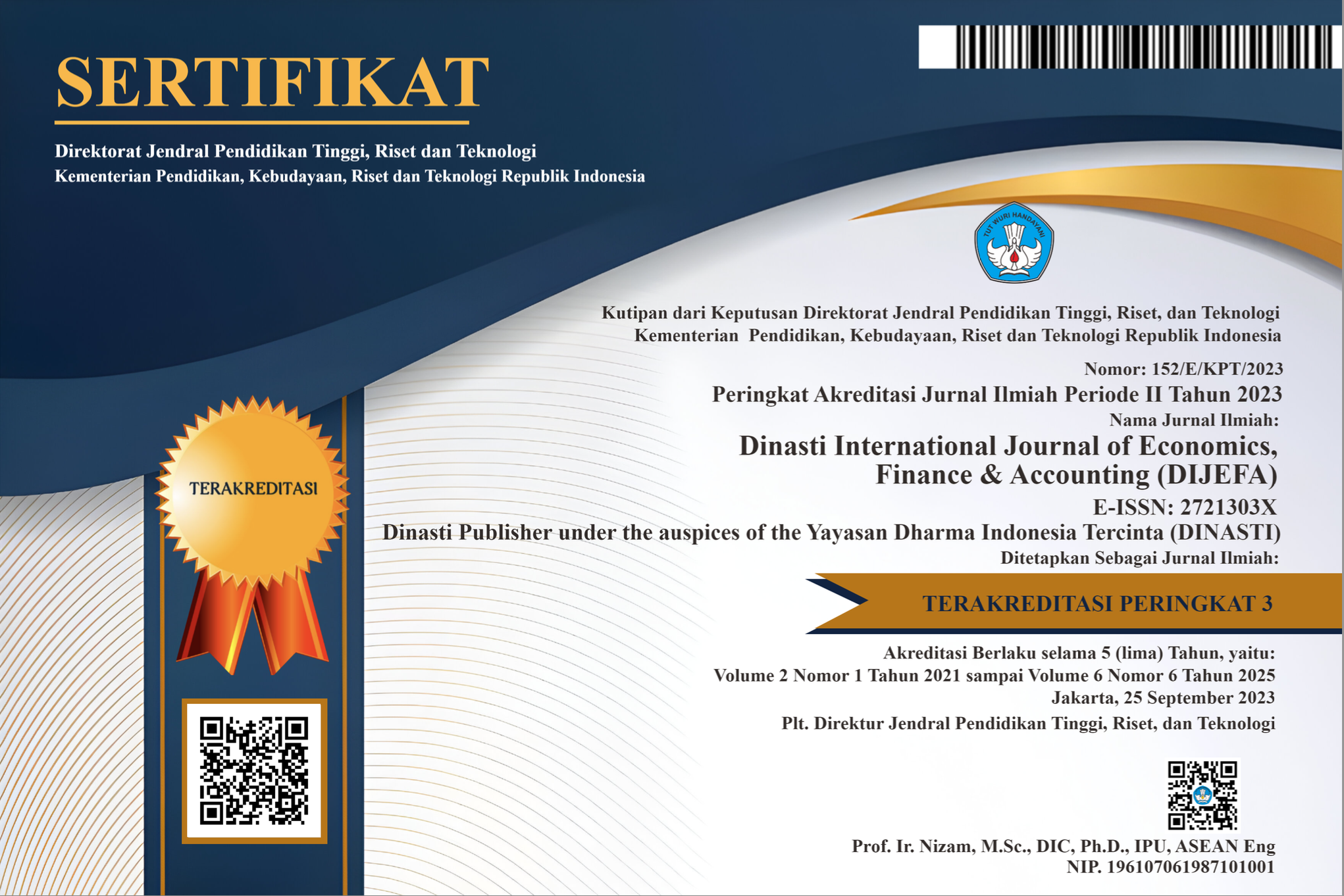Analysis Of Property Financing Development Using Musyarakah Mutanaqisah Contract At Islamic Banks In Medan City With ANP BOCR Approach
DOI:
https://doi.org/10.38035/dijefa.v5i3.3062Keywords:
Property Financing, Musyarakah Mutanaqisah, Islamic Bank, ANP BOCRAbstract
This study aims to analyze the problem of developing mutanaqisah musyarakah contracts in property financing by reviewing the benefits, opportunities, costs, and risks involved in mutanaqisah musyarakah contracts. This research uses a mix method between qualitative and quantitative with the ANP BOCR approach with the help of superdecision software. This research consists of four stages of research including pre-research, data collection, data processing and interpretation of results. The results of this study indicate that the ANP BOCR analysis regarding the development of property financing using the musyarakah mutanaqisah contract which is the top priority in the BOCR criteria aspect is Benefit with a Normalize value of 0.35644, followed by the risk aspect in second place with a value of 0.32573, followed by the opportunity aspect with a value of 0.19358 and in the last rank is the cost aspect with a value of 0.12426. The top priority in alternative strategies in developing property financing using the musyarakah mutanaqisah contract is the strategy that banks must work with honest developers. The next strategy is a socialization strategy, namely the bank conducts socialization to the public so that people understand more about the mutanaqisah musyarakah contract. In the third rank is to develop competitive and innovative products. Furthermore, the last rank is a promotion strategy in the form of banners, banners and billboards. Based on the calculation of the benefit cluster, each cluster has the same value, it means that the three benefit subcriteria have the same priority. Furthermore, in the opportunity cluster, the top priority is the development of property investment, followed by product innovation and needs according to the financing contract. Then in the cost cluster, the priority of the cost cluster is notary fees, followed by insurance costs in second place and administrative costs in third place. And in the risk cluster, the priority is credit risk, followed by market risk and compliance risk.
References
Abdullah, A. (2022). Comparative analysis of murabahah and musyarakah mutanaqisah contract in Islamic home financing ownership at Islamic bank: Case in BTN Syariah Surakarta (Billion Rupiah) Mudharabah Qardh Musyarakah Istishna Murabah Ijarah. 1(2), 226-232.
Alrasyid, H. (2022). Introduction to Islamic Economics. PT Global Executive Technology.
Amjadalah Alfie, A., & Khanifah, M. (2018). Natural Certainty Contract (NCC) Financing and Natural Uncertainty Contract (NUC) Financing on the Profitability of Islamic Commercial Banks. IQTISAD, 5. https://doi.org/http://dx.doi.org/10.31942/iq.v5i2.2550
Anggraini, T., Nasution, M. Y., & Soemitra, A. (2021). Implementation Strategy of the Mutanaqishah Musyarakah Academic at Home Ownership Financing in Sharia Banks in Indonesia. 2394-2415.
Ascarya. (2013). Islamic Bank Agreements & Products. PT Raja Grafindo Persada.
Bahari, Z., Hatizal, N., & Doktoralina, C. M. (2019). Study of Direct Relationship Determinants on the Selection of Musyarakah Mutanaqisah (MM) Products. 8(5), 501-508.
Bank Syariah Indonesia. (2023). FINANCIAL REPORT (Vol. 2022, Issue September).
Dahlan, A. (2018). Islamic Bank (Theory, Practice, Criticism). KALIMEDIA.
Department of Islamic Banking, & O. (2016). Product Standard Book: Musyarakah Book 2: Musyarakah Mutanaqisah. OJK.
Department of Islamic Banking, & OJK (2016). Product Standard Book 1: Musyarakah Book 2: Musyarakah Mutanaqishah. Musyarakah and Musyarakah Mutanaqishah Product Standard, 1-277.
become-the-best-property-investment-destination-in-the-world
Haris, H. (2007). Home Ownership Financing (An Innovation in Shari'ah Banking Financing). La_Riba, 1(1), 113-125. https://doi.org/10.20885/lariba.vol1.iss1.art8
Haroen, N. (2000). Fiqh Muamalah. Gaya Media Pratama Kencana.
Hasan, M. I. (n.d.). Principles of Research Methodology.
Hendry, A. (1999). Islamic Banking. Muamalah Institute.
Hidayat, A. M., Nurhasanah, N., & Ibrahim, M. A. (2018). Comparative Analysis of Murabahah and Musyarakah Mutanaqisah Agreements on Home Ownership Financing (KPR) with the AHP Method (Study at Bank Negara Indonesia Syariah Buah Batu Branch Office). Sharia Economic Law, 4(2), 471-476.
Imronah, 'Ainul. (2018). Implementation of Musyarakah Mutanaqishah. Al-Intaj: Journal of Economics and Islamic Banking, 4(1), 34-50.
Ismail, F. (2020). Mur?ba?ah Penalty Clause is Rib? in Disguise! The Penalty Clause Questions the Deep-rooted Preference for Literal Interpretation over Substantial Interpretation of Rib?. 35, 1-18. https://doi.org/10.1163/15730255-bja10037
J Moleong, L. (2005a). Qualitative Research Methods. Teenage Rosda Karya.
J Moleong, L. (2005b). Qualitative Research Methods. Teenage Rosda Karya.
Karim, A. A. (2017). Islamic Macroeconomics. PT Raja Grafindo Persada.
Cashmere. (2013). Banks and Other Financial Institutions. Rajawali Press.
Langi, G. P., & Mawardi, I. (2020). Risk Management of Mutanaqisah Musyarakah Financing at Bank Muamalat Indonesia Kc Mas Mansyur Surabaya. Journal of Sharia Economics Theory and Applied, 6(1), 188. https://doi.org/10.20473/vol6iss20191pp188-197
Mardani. (2011). ISLAMIC ECONOMIC VERSES AND HADITH. Raja Grafindo Persada.
Midania, Z., & Septiano, R. (2023). Analysis of Financial Factors Affecting the Market Share of Islamic Banking in Indonesia. Pundi Journal, 7(1), 93. https://doi.org/10.31575/jp.v7i1.456
Muhammad. (2002). Islamic Bank Management. UPP STIM YKPN.
Muhammad. (2005). Islamic Bank Financing Management. YKPN Academy of Company Management.
Muhammad. (2018). Islamic Bank Management. UPP STIM YKPN.
Mukhlisin, A., & Suhendri, A. (2018). Product Development Strategy of Islamic Banks in Indonesia. JES (Journal of Islamic Economics), 3(1), 60-70. https://doi.org/10.30736/jes.v3i1.51
Nafik, M., & rofiul, W. (2018). Islamic Bank Management (3rd ed.). UAD Press.
Nur Aisiyah, B. (2015). Islamic Bank Financing Management. Kalimedia.
Nurbaiti, N., Asmuni, A., Soemitra, A., Imsar, I., & Aisyah, S. (2023). Behavior analysis of MSMEs in Indonesia using fintech lending comparative study between sharia fintech lending and conventional fintech lending. JPPI (Journal of Indonesian Education Research), 9(4), 92. https://doi.org/10.29210/020232273
Nurhayati, Y., & Hasan, A. (2022). Analysis of the Mutanaqisah Musyarakah Contract as a Solution for Home Ownership Financing in Islamic Banking. Indonesian Interdisciplinary Journal of Sharia Economics (IIJSE), 5(1), 390-408. https://doi.org/10.31538/iijse.v5i1.1770
Financial Services Authority. (2023). Islamic Banking Statistics. https://ojk.go.id/id/kanal/syariah/data-dan-statistik/statistik-perbankan-syariah/Pages/Statistik-Perbankan-Syariah---Oktober-2023.aspx
P. Wilson, J. (2004). Human Resource Development, Learning & Training for individuals & organizations (2 nd editi). British Library.
Indonesian BMT Association. (2014). Sharia Akad Guidelines (PAS) of the Indonesian BMT Association. PT Permodalan BMT Ventura.
Rahman, N. R., Indriyani Sitepu, N., & Syukri, S. (2022). Implementation of Musyarakah Mutanaqisah Agreement in Syariah Banking. At-Tijaroh: Journal of Management Science and Islamic Business, 8(441), 224-242.
Law of the Republic of Indonesia Number 10 of 1998 Concerning the Amendment of Law Number 7 of 1992 Concerning Banking, 1 (1998). https://bphn.go.id/data/documents/98uu010.pdf
Rianto, M. N. (2012). Basics of Islamic Bank Marketing. Alfabeta.
Ridwan, M. (2004). Profit Sharing Techniques of Islamic Banks. UII Press.
Ridwan, M. (2007). Construction of Indonesian Islamic Bank. SM Library.
Rifa'i, M. (2002). The Concept of Islamic Banking. Wicaksana.
Rivai, V., & Arifin, A. (2010a). Islamic Banking: A Theory, Concept and Application. Bumi Aksara.
Rivai, V., & Arifin, A. (2010b). Islamic Banking: A Theory, Concept and Application. Bumi Aksara.
Rusyd, I. (2013). Bidayatul Mujtahid Wa Nihayatul Muqtashid (Translation C). Akbar Media.
Saaty, T., & Vargas, L.. (2006). Decision Making with the Analytic Network Process Economic, Political, Social and Technological Applications with Benefits, Opportunities, Cost and Risk. Pittsburgh: Springer.
Sangadji, E. M., & Sopiah. (2010). Research Methods Practical Approach in Research. Andi Offset.
History of Medan City. (2024). Pemko Medan. https://pemkomedan.go.id/hal-sejarah-kota-medan.html
Sitorus, R. (2019). Application of the Musyarakah Mutanaqisah Akad on KPR (Home Ownership Credit) Bank BRI Syariah Medan Branch Office S. Parman. http://repository.uinsu.ac.id/id/epringt/6181
Sugiyono. (n.d.). Research Methods.
Sumar'in. (2012). Institutional Concepts of Islamic Banks. Graha Ilmu.
Syafe'i, R. (2012). Fiqh Muamalah. Faithful Library.
Syafi'I Antonio, M. (2001). Islamic Banking: from Theory to Practice. Gema Inzani and Tazkia Cendikia.
Tjiptono, P., & Chandra, G. (2012). Strategic Marketing. Andi Offset.
Turmudi, M. (2016). Management of Problem Financing Settlement in Islamic Banking Institutions. Li Falah: Journal of Islamic Economics and Business Studies, 1(1), 95. https://doi.org/10.31332/lifalah.v1i1.477
Utama, S. M., Farid, D., Husni, M., Pakarti, A., Al, K., Mabruri, K., & Rohman, H. F. (2023). Application of the Musyarakah Mutanaqishah Akad in Financing Sharia Home Ownership Loans Aster Village Ciwastra at Bank Syariah Indonesia. 9(03), 4177-4191.
Wahbah Zuhaili. (1999). Fiqh Muamalat Islamic Banking Kapita Selekta Al-Fiqhu Al-Islam Wa Adillatuhu. Bank Muamalat Indonesia.
Wiroso. (2009). Sharia Banking Products. LPEE Usakti.
Zubir, Z., Muhazir, M., & Wahyudani, Z. (2023). Akad al-Ijarah al-Mausufah fi al-?immah in Sharia Banking in Aceh: A Study of Home Ownership Finance. Justicia Islamica, 19(2), 311-330. https://doi.org/10.21154/justicia.v19i2.3653
Downloads
Published
How to Cite
Issue
Section
License
Copyright (c) 2024 Putri Rahma, Zuhrinal M. Nawawi, Nurbaiti Nurbaiti

This work is licensed under a Creative Commons Attribution 4.0 International License.
Authors who publish their manuscripts in this journal agree to the following conditions:
- The copyright on each article belongs to the author(s).
- The author acknowledges that the Dinasti International Journal of Economics, Finance & Accounting (DIJEFA) has the right to be the first to publish with a Creative Commons Attribution 4.0 International license (Attribution 4.0 International (CC BY 4.0).
- Authors can submit articles separately, arrange for the non-exclusive distribution of manuscripts that have been published in this journal into other versions (e.g., sent to the author's institutional repository, publication into books, etc.), by acknowledging that the manuscript has been published for the first time in the Dinasti International Journal of Economics, Finance & Accounting (DIJEFA).


























































